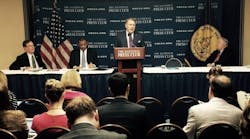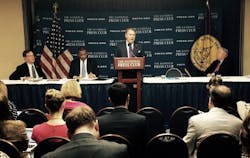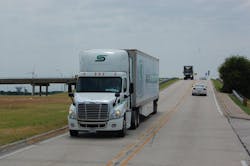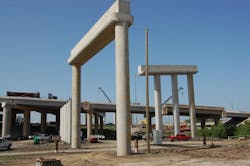“Transportation is the one thing we all must do together,” Foxx noted in his remarks (you can read his entire speech here).
“We can’t imagine it by ourselves. We can’t pay for it by ourselves. We can’t build it by ourselves. But look at what is done for us generation after generation,” he stressed. “We are exceptional because every generation picks up from where the last generation left off and carries it forward.”
But that “generational ethic” as Foxx called it is under assault right now where transportation spending is concerned.
“Are we the same country that built the Erie Canal and Transcontinental Railroad? Are we the same country that built the Golden Gate Bridge, iconic train stations, and completed the Eisenhower Interstate Highway System? Are we same the country that led the way in moving freight and building mass transit?” he asked.
“What yardstick are we using to measure success? Is our goal solvency of the Highway Trust Fund?” Foxx said. “The Highway Trust Fund is not an outcome. It is not a result. It is a tool. If your dishwasher is broken, you are not fixing the problem by finding the wrench. The wrench may help you but only if you focus on what’s wrong with the dishwasher.”
The question, then, is what kind of future transportation will have in the U.S. “Do we want commutes tomorrow to be longer? Do we want roads to be in such disrepair that we can’t even keep up with maintenance? Do we want our bridges to fall into such a state of disrepair that they are impassable?”“Infrastructure investment is not about Democrats or Republicans,” The Teamsters’ Hoffa said. “It’s about doing what’s right for America. Our nation’s bridges, roads, airports and ports are crumbling and it is time for Congress to hammer out a bipartisan plan that invests in our nation’s infrastructure.”
Gov. Barbour expressed a similar belief – that repairing and updating U.S. transportation our infrastructure is a “key” to the country’s economic health and future growth.
“Our infrastructure moves freight and people, but in a larger sense it moves our economy,” he said.
None of the “Big Three” shirked from discussing the price tag they believe is necessary to bring the U.S. transportation system up to where it needs to be in terms of capacity: at a minimum, $400 billion over six years.
“The American people know we need a better transportation system,” DOT’s said. “They know we need to pay for it.”
Ah, yes, now we come to the heart of the matter: more money. It’s always about getting more money, isn’t it?
The problem that keeps getting glassed over (indeed, it seems to be deliberately forgotten in many cases) is that there was this thing called “the stimulus bill” back in 2009 – a nearly $1 trillion government funding effort aimed at “jump starting” the U.S. economy out of the Great Recession, particularly via infrastructure projects. That’s more than twice the amount being sought over six years in some of the current highway bill iterations.So where did all that money go? Not into transportation infrastructure; at least, not much of it.
None other than Rep. Peter DeFazio (D-OR) – as rock-ribbed a Democrat as you’ll find – took the Obama administration to task back in February for the
“Even in the most optimistic view, just 7% of that bill went towards infrastructure investment, with just 4% [focused] on surface transportation infrastructure,” he noted. “Basically, the Obama people hated infrastructure; they thought it was old school and didn’t want to go there. But the president kept talking about it like we were doing it so the public got skeptical.”
Greg Cohen, CEO of the American Highway Users Alliance made a similar point last month during a panel discussion in Dallas, TX, noting that one the “failure” of the stimulus bill to address infrastructure needs is one reason highway funding is such a contentious political issue today.
“Only 3% of the stimulus funds – just $27 billion – went to roads, with only 4.5% in total spent on infrastructure needs,” he said. “That was money wasted. So it’s no wonder politicians are scared to try and raise more funds for roads. It’s also why they’ve kept funding flat over the last seven years.”
There’s also this interesting story penned last year by Noah Smith, an assistant professor of finance, which illustrates the many ways the U.S. tends to overinflate its infrastructure costs in big ways.
This is part of the larger and much more trouble issue: even as the demands being placed on our transportation network are projected to grow significantly over the next 30 years, there’s precious little respect being given to how transportation underpins the quality of life we enjoy today in our country.
That’s all in the mix as the debate over the funding and future direction of America’s surface transportation system continues.






